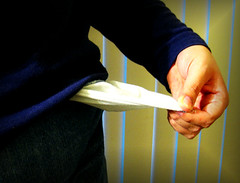Article courtesy of European Journalism Centre
 Before hanging himself from a tree in the garden of his house in Puglia, Pierpaolo Faggiano revealed in a letter what had driven him to this extreme act: his precarious working conditions.
Before hanging himself from a tree in the garden of his house in Puglia, Pierpaolo Faggiano revealed in a letter what had driven him to this extreme act: his precarious working conditions.
For decades the 41-year-old Italian journalist had been a regular contributor to a local newspaper, barely eking out EUR 4 to 20 per article.
Following Faggiano’s suicide many journalists started blaming the unequal Italian media environment for protecting only a small number of regularly paid employees, forcing others to survive on meagre incomes.
The incident unleashed a wave of protests among Italian journalists and bloggers who started asking, on online platforms and in street demonstrations, for more respectable labour conditions.
They pointed the finger at the increasing number of media organisations that use underpaid freelancers as regular contributors.
The protests also drew attention to the knots and holes of the old-fashioned and gerontocratic Italian media system and blamed it for undermining high quality journalism through the wide practice of nepotism in the recruiting process of journalists.
Italian media does not favour a free and competitive job market, the demonstrators claimed.
Widespread low pay
The dire situation was already manifest long before the incident. “In the last year or two, there has been a growing awareness of the illegal working conditions that oppress journalists,” said 31-year old freelance reporter Maria Raffaella Cosentino.
Cosentino was in the Calabrian town of Rosarno and later in Castel Volturno, near Naples, during the violent clashes between immigrant day labourers and residents in January and February 2010 and says she realised at that moment that many local and national TV and print journalists covering the event were paid less than the EUR 50 per day that the fruit and vegetable pickers were demanding from the landowners.
Cosentino decided to write an e-book on the topic, Quattro per cinque (“Four per five”)*, and to launch a campaign “Non lavoro per meno di cinquanta euro,” calling on journalists to turn down assignments which would pay less than EUR 50 per article.
According to a 2010 national survey by the ODG the low-pay practice is indifferently carried out by national newspapers, magazines and television stations.
The study revealed that many print or online newspapers such as Il Messaggero, la Repubblica, Il Tempo or the national news agency ANSA, pay EUR 2 to an average of EUR 20 for articles of varying length.
In some cases, reporters who had written for the leftist daily publication Il Manifesto said they had never been paid.
The situation is no different at television stations, where a number of local journalists earn a wage of EUR 12 for shooting, editing, writing, and doing the voice-over for a story.
Conditions are not better even at the Italian national broadcasting company RAI. “I made fifteen 20-minute-long features for RAI,” said Roberta Borcella, a 40-year-old freelance video journalist. “I worked nearly one month to produce each video, for which I received eight months later a net income of EUR 900, my cameraman’s costs included.”
The information and communication sector is feeling the pinch everywhere. But while many media outlets in other parts of the world are experimenting with new strategies and investing in innovation, Italian journalism is still struggling with a personal identity crisis.
“[Italian journalism] is too awkward, past-oriented and absurdly self-referential. It doesn’t just report on the country’s state of affairs, it is a complete part of them,” former Reuters reporter Roberto Bonzio said in an interview.
According to official rules, Italian aspiring journalists have two options in order to obtain a professional writing licence from the Italian Order of Journalists ODG, the state-approved organisation which regulates Italian journalism.
The first option is to undergo a 18-month training in a media outlet or to enroll in one of the 16 journalism schools recognised by the Order, and to pass a national final exam to become full-time professionisti.
The second option for aspiring journalists is to become part-time pubblicisti. In this case, they need to prove that they have carried out a two-year paid journalistic activity and produced 60-80 articles.
But a writer’s license does not necessarily guarantee a job as a journalist.
An ambiguous status
In addition to this distinction, says Robert Bonzio, Italian journalists can be divided into two categories: the elite who benefits from a standard journalistic contract, and all the rest. “[This privileged minority] is like a blockhouse of times gone by. Outside of this group, there are a number of underpaid contributors – most of whom are full time journalists working without any form of protection – who are forced to endue their editors’ blackmails and whims.”
The condition of this group of outsiders is so unclear that it is difficult to even define their job status. Most of them are freelancers or precari.
But the word “freelancer,” commonly used to refer to self-employed workers who write for various clients on a temporary basis, is ambiguously used in Italy to refer to a confusingly wide range of media professionals working from piece-writers to regular contributors with no contract.
Precari on the other hand is a term referring to workers on temporary and short-term contracts, who live in precarious financial situations because of this type of employment.
In a country where the average annual salary in 2009 amounted to about EUR 16,000, according to OECD figures, an LSDI webzine survey revealed that over 55 percent of Italian freelancers and nearly 50 percent of precari journalists earn less than EUR 5,000 per year.
Only about 19 percent of journalists are permanent full-time employees. Their salaries vary between EUR 30,000 to 50,000 per year.
The survey also revealed that the number of unemployed journalists soared to nearly 5.000 by the end of 2010, representing an increase of 44 percent compared to 2002.
When the issue was brought to Parliament, Italian MPs condemned the exploitation of media workers and called on editors to apply respectable payments.
They also expressed concern over the fact that underpaid journalists are more easily liable to be blackmailed.
The Parliament’s Culture Committee on October 26, 2011 approved a bill affirming the right of journalists to receive an “adequate payment”, but the act is just at the beginning stage of the legislative process. When and if it is finally approved, it will provide a framework against journalists’ exploitation.
“In the past a young journalist would get trained over time and climb up the career ladder until reaching the status of full-time employee,” commented Alessandra Comazzi, a representative of the FNSI trade union. “But now Italian freelancers seem to stay in a state of eternal limbo of exploited trainees.”
A stagnant and gerontocratic media job market
Journalists who apply for a full-time position often encounter a media recruitment system that is largely based on nepotism. When asked about the way they managed to obtain a full-time contract, some journalists refer to luck, and others simply do not answer.
Job openings in journalism are rarely advertised and the hiring process mostly depends on one’s connections. This mechanism tragically affects the quality of staff writers, who are not necessarily hired in accordance with their merit.
“The reason that Italian journalism – in particular, television journalism – is of very poor quality is due to the fact that the selection of individuals who are allowed into the system starts after the exclusion of the smartest people and of everyone who would be inclined to practise journalism as a public service,” said Wolfgang Achtner, a Rome-based TV journalist and former ABC news, CNN and Press TV correspondent with a long experience in Italian television.
Moreover, the media job market, already small, is partly controlled by the Order of Journalists. Often, one of the first application requirements is to be licensed by the Order. The structure of many newsrooms mirrors that of the Order, because they are made up by journalists licensed by the Order, who, in turn, will only consider hiring new colleagues licensed by the Order.
Even if the Order of Journalists strives to work out an agreement with the National Journalists Union (FNSI) and the Federation of Editors and Publishers (FIEG) to increase the payment of freelancers and precari, licensed and non-licensed journalists alike hold the ODG as one of the responsible parties for Italy’ s stagnant and gerontocratic media job market.
“The Order is a fascist relic whose main purpose is to perpetuate itself. Press freedom, independence or quality of information, are not its goals,” says U.S. editor at IJNET Nicole Martinelli, who worked as a foreign freelancer registered with the Order for about 10 years. “Yet you can’t be a professional journalist of any standard without belonging to it. The Order is a bottleneck to the profession that forces a lot of talent out.”
The Order’s response to the freelancers’ protests and requests came on September 8, 2011 with the launch of a new Internet portal dedicated to sharing news and experiences from temporary media journalists.
The website served as a platform to discuss the draft of a new bill of rights, the so-called “Carta di Firenze.” It was conceived as an instrument to request better wages for freelancers and precari. In theory, it allows the Order to take disciplinary actions against exploitation of journalists.
An agreement between the Order and freelancers and precari was signed during a demonstration held in Florence on October 7-8 of several hundred journalists asking for better work conditions.
“[The portal and the demonstration] are not enough and they come too late, absolutely. But better late than never,” commented an Italian journalists group on Linkedin.
While many expressed doubts on social media platforms about the ODG measures, the participants of the demonstration in Florence affirmed their commitment to improve the situation of underpaid Italian journalists.
“Our goal is not to undermine the working conditions of our full-time colleagues, but we are asking for an adequate compensation for the others,” said Nicola Chiarini from the freelancers association in Veneto. “A precarious journalism means a precarious democracy.”
* Maria Cosentino said that the idea of the title “Quattro per cinque” came from a specific incident that happened to a journalist in the Calabria region. The journalist was wounded by five bullets shot at him for a report on the mafia (‘ndrangheta), and was paid 4 cents per line. Cosentino used the case as an example and metaphor.
Original article can be viewed at the European Journalism Centre.
Tags: Freelance Wages, High Quality Journalism, Italian Journalism, Italian Order of Journalists, Low Pay, Maria Raffaella Cosentino, Pierpaolo Faggiano, Roberto Bonzio













































